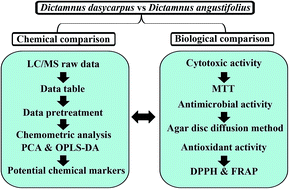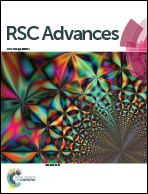Plant metabolomics driven chemical and biological comparison of the root bark of Dictamnus dasycarpus and Dictamnus angustifolius†
Abstract
The root bark of Dictamnus dasycarpus (DD) and Dictamnus angustifolius (DA), two commonly used traditional Chinese medicines from the genus Dictamnus (Rutaceae), have been widely used for the treatment of skin ulcer, skin inflammation and other related inflammatory diseases in clinical therapy. The present study compares the chemical and biological differences between DD and DA. An ultra-fast liquid chromatography-tandem mass spectrometry (UFLC-MS/MS)-based plant metabolomics approach has been employed to compare the chemical profiles of DD and DA. 16 chemical markers, including 4 degraded limonoids, 3 limonoids and 9 furoquinoline alkaloids, were identified and the results indicated that there were significant differences in the chemical composition between the two medicinal plants. The methanolic extracts of DA have a relatively higher level of many major furoquinoline alkaloids than that of DD, whereas DD contains more degraded limonoids and limonoids. In addition, the cytotoxic, antimicrobial and antioxidant activities of chemical markers and methanolic extracts of these two medicinal herbs were evaluated. The results presented in this study suggest that DD and DA possess cytotoxic, antimicrobial and antioxidant activities. However, the extracts of DA showed significantly stronger activities than DD in these three bioactivity tests mentioned above. Bioassays also suggested that furoquinoline alkaloids may play a major role in the bioactivities of these two plants and thus could be used as references for quality control.


 Please wait while we load your content...
Please wait while we load your content...